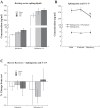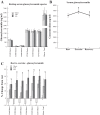Serum sphingolipids: relationships to insulin sensitivity and changes with exercise in humans
- PMID: 26126684
- PMCID: PMC4537923
- DOI: 10.1152/ajpendo.00134.2015
Serum sphingolipids: relationships to insulin sensitivity and changes with exercise in humans
Abstract
Ceramides and sphingolipids are a family of lipid molecules that circulate in serum and accumulate in skeletal muscle, promoting insulin resistance. Plasma ceramide and dihydroceramide are related to insulin resistance, yet less is known regarding other ceramide and sphingolipid species. Despite its association with insulin sensitivity, chronic endurance exercise training does not change plasma ceramide and sphingolipid content, with little known regarding a single bout of exercise. We measured basal relationships and the effect of acute exercise (1.5 h at 50% V̇o2 max) and recovery on serum ceramide and sphingolipid content in sedentary obese individuals, endurance-trained athletes, and individuals with type 2 diabetes (T2D). Basal serum C18:0, C20:0, and C24:1 ceramide and C18:0 and total dihydroceramide were significantly higher in T2D and, along with C16:0 ceramide and C18:0 sphingomyelin, correlated positively with insulin resistance. Acute exercise significantly increased serum ceramide, glucosylceramide, and GM3 gangliosides, which largely decreased to basal values in recovery. Sphingosine 1-phosphate and sphingomyelin did not change during exercise but decreased below basal values in recovery. Serum C16:0 and C18:0 ceramide and C18:0 sphingomyelin, but not the total concentrations of either of them, were positively correlated with markers of muscle NF-κB activation, suggesting that specific species activate intracellular inflammation. Interestingly, a subset of sphingomyelin species, notably C14:0, C22:3, and C24:4 species, was positively associated with insulin secretion and glucose tolerance. Together, these data show that unique ceramide and sphingolipid species associate with either protective or deleterious features for diabetes and could provide novel therapeutic targets for the future.
Keywords: athlete's paradox; insulin sensitivity; lipid composition; plasma biomarkers.
Copyright © 2015 the American Physiological Society.
Figures







References
-
- Amati F, Dubé JJ, Alvarez-Carnero E, Edreira MM, Chomentowski P, Coen PM, Switzer GE, Bickel PE, Stefanovic-Racic M, Toledo FG, Goodpaster BH. Skeletal muscle triglycerides, diacylglycerols, and ceramides in insulin resistance: another paradox in endurance-trained athletes? Diabetes 60: 2588–2597, 2011. - PMC - PubMed
-
- Baranowski M, Charmas M, Dlugolecka B, Gorski J. Exercise increases plasma levels of sphingoid base-1 phosphates in humans. Acta Physiol (Oxf) 203: 373–380, 2011. - PubMed
-
- Barbarroja N, Rodriguez-Cuenca S, Nygren H, Camargo A, Pirraco A, Relat J, Cuadrado I, Pellegrinelli V, Medina-Gomez G, Lopez-Pedrera C, Tinahones FJ, Symons JD, Summers SA, Oresic M, Vidal-Puig A. Increased dihydroceramide/ceramide ratio mediated by defective expression of degs1 impairs adipocyte differentiation and function. Diabetes 64: 1180–1192, 2015. - PMC - PubMed
Publication types
MeSH terms
Substances
Grants and funding
LinkOut - more resources
Full Text Sources
Other Literature Sources
Medical

